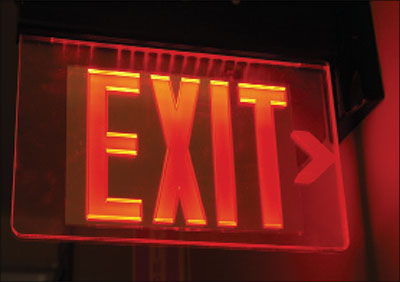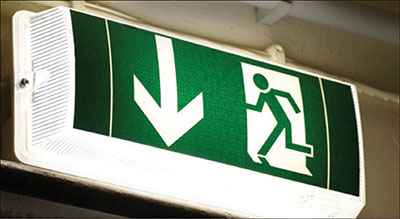And certain provisions of the legally mandated documents do not help the Code users.
Let’s elaborate: provisions for installations of exit signs are governed by Rule 46-400 of the Canadian Electrical Code (CEC).
This Rule states the following requirements:
“46-400 Exit signs
(1) Where exit signs are connected to an electrical circuit, that circuit shall be used for no other purpose.
(2) Notwithstanding Subrule (1), exit signs shall be permitted to be connected to a circuit supplying emergency lighting in the area where these exit signs are installed.
(3) Exit signs in Subrules (1) and (2) shall be illuminated by an emergency power supply where emergency lighting is required by the National Building Code of Canada.”
Appendix B Note on this Rule offers the following clarification:
“Rule 46-400
This Rule applies only to exit signs connected to an electrical circuit. Other requirements for exit signs, including those not connected to an electrical circuit, may be found in Section 3.4.5 of the National Building Code of Canada.
Rule 46-400(2)
The circuit supplying emergency lighting could be ac or dc. The National Building Code of Canada requires that exit signs be illuminated continuously while the building is occupied. Caution should be taken to ensure that a circuit supplying both emergency lighting and exit signs is not controlled by a switch, time clock, or other means.”
So far, requirements of the CEC appear to be straightforward, and the users of the electrical installation code clearly understand that in accordance with the scope of Section 46, these requirements are only applicable when such exit signs are “required by the National Building Code of Canada” (by the NBCC).

Photo 1. Old type exit sign—with the word “exit”

Photo 2. New type exit sign—with the green running man
As the NBCC is the “driving force” in respect to the application of exit signs, let’s take a look at the relevant provision of the NBCC.
Sentence 3.4.5.1.(1) of the NBCC states the following requirements for location of exit signs:
“3.4.5.1.(1) Every exit door shall have an exit sign placed over or adjacent to it if the exit serves
a) a building more than 2 storeys in building height,
b) a building having an occupant load of more than 150, or
c) a room or floor area that has a fire escape as part of a required means of egress.”
Sentences 3.4.5.1.(6) and (7) provide additional requirements for location of exit signs as follows:
“6) Where no exit is visible from a public corridor, from a corridor used by the public in a Group A or B major occupancy, or from principal routes serving an open floor area having an occupant load of more than 150, an exit sign conforming to Clauses (2)(b) and (c) with an arrow or pointer indicating the direction of egress shall be provided.
7) Except for egress doorways described in Sentence 3.3.2.4.(4), an exit sign conforming to Sentences (2) to (5) shall be placed over or adjacent to every egress doorway from rooms with an occupant load of more than 60 in Group A, Division 1 occupancies, dance halls, licensed beverage establishments, and other similar occupanciesthat, when occupied, have lighting levels below that which would provide easy identification of the egress doorway.”
So far – so good, as these NBCC provisions advise the code users of all possible locations where exit signs would be required.
Now, let’s take a look at what NBCC tells the Code users regarding performance of the required exit signs.
Sentence (2) of Article 3.4.5.1. mandates the following performance requirements for exit signs:
“(2) Every exit sign shall
(a) be visible on approach to the exit,
(b) except as permitted in Sentence (3), consist of a green pictogram and a white or lightly tinted graphical symbol meeting the colour specifications referred to in ISO 3864-1, “Graphical symbols – Safety colours and safety signs – Part 1: Design principles for safety signs in workplaces and public areas,” and
(c) conform to the dimensions indicated in ISO 7010, “Graphical symbols –Safety colours and safety signs – Safety signs used in workplaces and public areas,” for the following symbols (see Appendix A):
i) E001 emergency exit left,
ii) E002 emergency exit right,
iii) E005 90-degree directional arrow, and
iv) E006 45-degree directional arrow.”
Sentence (3) of Article 3.4.5.1. now mandates that internally illuminated exit signs must be illuminated continuously (and that such continuous illumination is required not only when a building is occupied, but at all times). This Sentence appears to allow two options for the internally illuminated exit signs: to be illuminated by being connected to an electrical circuit or by being able to provide “self-illuminating” capabilities, as follows:
“(3) Internally illuminated exit signs shall be continuously illuminated and
(a) where illumination of the sign is powered by an electrical circuit, be constructed in conformance with CSA C22.2 No. 141, “Emergency Lighting Equipment,” or
(b) where illumination of the sign is not powered by an electrical circuit, be constructed in conformance with CAN/ULC-S572, “Photoluminescent and Self-Luminous Signs and Path Marking Systems.”
It is also interesting to note that Sentence 3.4.5.1.(4) now recognizes externally illuminated exit signs that are illuminated not by being connected to an electrical circuit but by displaying self-illuminating properties as follows:
“(4) Externally illuminated exit signs shall be continuously illuminated and be constructed in conformance with CAN/ULC-S572, “Photoluminescent and Self-Luminous Signs and Path Marking Systems.”
Finally, the NBCC appears to confuse the users by the following statement in Sentence 3.4.5.1.(5):
“(5) The circuitry serving lighting for externally and internally illuminated exit signs shall
(a) serve no equipment other than emergency equipment, and
(b) be connected to an emergency power supply as described in Article 3.2.7.4.”
This apparent confusion is manifested by the fact that Sentence (4) does not appear to mandate illumination of externally illuminated exit signs by external lighting being connected to an electrical circuit (it appears to rely on self-illuminating properties of such externally illuminated exit sign); however, Sentence (5) references the “circuitry serving lighting for externally and internally illuminated exit signs.” To add to this confusion, Sentence (5) mandates that this circuitry must serve “no equipment other than emergency equipment.” Does it mean that this exit sign circuitry must serve such emergency equipment as a fire pump or firefighters’ elevator? This NBCC statement appears to be inconsistent with provisions of Rule 46-400 of the CEC quoted above as follows:
“46-400 Exit signs
(1) Where exit signs are connected to an electrical circuit, that circuit shall be used for no other purpose.
(2) Notwithstanding Subrule (1), exit signs shall be permitted to be connected to a circuit supplying Emergency lighting in the area where these exit signs are installed.”
So, let’s summarize the information presented above:
Exit signs are part of electrically connected systems mandated by the NBCC.
Article 3.4.5.1. of the 2010 edition of the NBCC has been clarified by removing wording “while building is occupied” from the requirements for the internally and externally illuminated exit signs to be continuously illuminated. Such clarification removed ambiguity on this essential safety requirement and allowed the users of the NBCC to appreciate significance of continuous illumination of exit signs in accomplishing fundamental safety objective in fire protection. NBCC introduced new signage on exit signs, by replacing the word “EXIT” by the green pictogram of a running man, as such pictogram meets provisions of the ISO standard.
However, Article 3.4.5.1. of the NBCC has also been revised – to recognize “Photoluminescent and Self-Luminous Signs” that are designed and constructed in conformance with the ULC standard S572 as the exit signs that meet the performance requirements of Sentence 3.2.7.1.(2); Sentence 3.2.7.3.(1) and Sentence 3.2.7.4.(1)(b) of the NBCC.
These NBCC Articles mandate the following performance requirements:
“3.2.7.1. Minimum Lighting Requirements
(1) An exit, a public corridor, or a corridor providing access to exit for the public or serving patients’ sleeping rooms or classrooms shall be equipped to provide illumination to an average level not less than 50 lx at floor or tread level and at angles and intersections at changes of level where there are stairs or ramps.
(2) The minimum value of the illumination required by Sentence (1) shall be not less than 10 lx.
3.2.7.3. Emergency Lighting
(1) Emergency lighting shall be provided to an average level of illumination not less than 10 lx at floor or tread level”
“3.2.7.4. Emergency Power for Lighting
(1) An emergency power supply shall be
(a) provided to maintain the emergency lighting required by this Subsection from a power source such as batteries or generators that will continue to supply power in the event that the regular power supply to the building is interrupted, and
(b) so designed and installed that upon failure of the regular power it will assume the electrical load automatically for a period of
(i) 2 h for a building within the scope of Subsection 3.2.6.,
(ii) 1 h for a buildingof Group B major occupancy classification that is not within the scope of Subsection 3.2.6., and
(iii) 30 min for a buildingof any other occupancy.”
Thus, such recognition of self-illuminated exit signs is articulated in Sentences 3.4.5.1.(3)(b) and (4)(b) of the NBCC, and as the result of this recognition the NBCC no longer mandates that the self-illuminated exist signs conforming to ULC S572 have to be illuminated from lighting connected to the electrical circuit.
When the internally illuminated exit signsconstructed to the CSA safety standard C22.2 No.141 are connected to an electrical circuit in accordance with Sentence 3.4.5.1.(3)(a) and in conformance with Rule 46-400 of the CE Code, the above referenced NBCC illumination performance requirements will be met. It means that under a normal power supply condition electrically connected exit signs will be continuously illuminated, and in the event of a normal power failure, the emergency power supply source will be provided to these electrically connected signs in accordance with the requirement of Sentence 3.2.7.4.(1)(a) of the NBCC. Such emergency power supply source will be able to provide continuous illumination of these electrically connected exit signs for a period mandated by the NBCC in accordance with the type of a building.
In addition, electrical connection of the internally illuminated exist signs will allow to conform with all applicable provisions of Sentence 3.4.5.1.(2)(b) of the NBCC (i.e. to comply with the ISO 3864-1 for a green pictogram and a graphical symbol), as each electrically connected internally illuminated exit sign complies with the CSA standard C860, “Performance of internally lighted exit signs.”
However, when “Photoluminescent and Self-Luminous Signs” (that are designed and constructed in conformance with the ULC standard S572), are installed in a building under provisions of Sentence 3.4.5.1.(3)(b), ability of each such “internally illuminated” exit sign to comply with provisions of the ISO 3864-1 for a green pictogram and a graphical symbol, and with provisions of the NBCC for a minimum of 10 lx of illumination under a power failure condition for a period up to 2 hours, is highly questionable, as the ULC S572 has no reference to the above stated NBCC performance requirements.
In addition, there is no requirement in the ULC S572 to mark these “Photoluminescent and Self-Luminous Signs” with the ULC certification monogram indicating that these self-illuminated exit signs conform to this ULC standard.
Thus, the users of the NBCC (designers, installers and regulators) would not have objective, consistent, transparent and measurable criteria for understanding whether such signs, in fact, meet the safety objectives of the NBCC for the illumination level and for the time period required for illumination at the NBCC prescribed level under power failure condition.
As was indicated above, Sentence 3.4.5.1.(4) of the NBCC creates confusion to the Code users, as this Sentence recognizes the signs constructed to the ULC S572 as also being “externally illuminated.”
This NBCC Sentence does not mandate an electric power supply source – to externally illuminate such signs in order to allow these signs to rely on their self-illuminating properties after the source of external illumination disappears.
It should be noted that the scope of the ULC S572 considers these signs to be furnished with “photoluminescent and self-luminous” properties (i.e., signs that are being illuminated by means of the internal self-illuminating attributes, but only after a source of ambient lighting to which these signs are exposed under normal conditions, disappears).
In fact, the following definition is provided in the ULC S572 “SELF-LUMINOUS — Illuminated by a self-contained energy source other than a battery, such as radioactive tritium gas. Operation is independent of external power supplies or other external forms of energy.”
Sentence 3.4.5.1.(4) simply outlines the requirements for circuitry serving lighting for externally and internally illuminated exit signs, but there is no requirement in Article 3.4.5.1. for the externally illuminated exit signs – to be illuminated by the lighting in the area where such signs are installed. And it was already noted that the wording of paragraph 3.4.5.1.(5)(a) is questionable, as it mandates “circuitry serving lighting for externally and internally illuminated exit signs serve no equipment other than emergency equipment.”
In light of the fact that the emergency equipment is not defined by the NBCC but is described in Article 3.2.7.9., the Code users might be under impression that the circuitry serving lighting for externally and internally illuminated exit signs could also serve such emergency equipment as fire pumps, fire fighters’ elevators, smoke control and smoke venting fans.
The writer of this article has advised the NRC staff that confusion related to this wording must be expediently removed from the Code, as this wording conflicts with 32-206 and Rule 46-400 of the CEC and with requirements of NFPA 20.
Electrically connected exit signs must be supplied only from a dedicated circuit or from a circuit that supplies emergency power to the lighting in the area where such exit signs are installed. Failure to recognize this fact in the NBCC will compromise the fire safety objective of the Code.
The writer of this article has recommended to the NRC staff the following:
1. Until ULC S572 is revised so, as to recognize performance requirements of the NBCC for illumination levels and the time period to provide such illumination levels by self-illuminating properties of the sign, to demonstrate compliance with the referenced NBCC performance requirements in specific tests reflected in the standard and to mandate marking by applying a certification monogram stating that each such sign is designed, constructed, tested and certified to the ULC S572 – to remove any references to self-illuminated exist signs and to the ULC S572 from the NBCC ASAP. Failure to do so will compromise fire safety.
2. To revise Sentences (3); (4) and (5) of Article 3.4.5.1. to read as follows:
“(3) Internally illuminated exit signs shall:
(a) be continuously illuminated;
(b) be connected to an electrical circuit; and
(c) conform to the CSA standard C22.2 No. 141.
(4) Externally illuminated exit signs shall be continuously illuminated by electrical circuits supplying lighting in the area where these exit signs are installed.
(5) Electrical circuits illuminating of exit signs described in Sentence (3) or (4) shall be:
(a)used for no other purpose; and
(b)connected to an emergency power supply as described in Article 3.2.7.4.”
Meanwhile, designers and installers of exit signs (if non-electrically connected exit signs are chosen for installation) should contact the relevant AHJ’s – to discuss all potential concerns.











Find Us on Socials